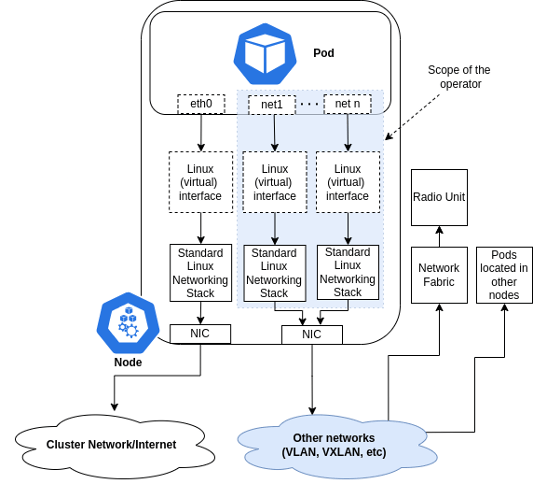
Keep up to date with our innovative initiatives.
Sign up here
As modern Smart Industry applications increasingly demand complex and flexible networking capabilities, this need becomes even more pronounced in 6G, where highly specialized network requirements such as ultra-low latency, high reliability, and seamless integration across diverse network technologies are key. While effective for general cloud workloads, traditional Kubernetes-native (K8s) networking functionality lacks the granularity and flexibility necessary to meet the stringent requirements of these advanced domains. In these advanced scenarios -ranging from dynamic network slicing in 6G to deterministic communication- the ability to deploy and control specific networking configurations, such as L2 and L3 links, is essential to provide enhanced flexibility to industrial deployments.
To address these challenges, i2CAT has developed the Custom Networking Kit. This K8s operator offers a comprehensive solution for declarative network configurations that can be applied directly to both Kubernetes workloads and nodes. By providing seamless integration with the Kubernetes ecosystem, the operator enhances flexibility and enables easy operation of distributed containerized industrial applications.
This approach simplifies network management for diverse workloads without requiring external networking tools or manual configuration, enabling OT operators to focus on specific application requirements and eliminating the need to perform complex configurations.

Figure X: Scope of the Custom networking Kit
Figure X represents the operator’s range of action. As it can be seen, the customized network configurations are achieved not only through configurations within the Kubernetes domain, but also by managing the host networking of the Kubernetes nodes:
In the following video demonstrator, we illustrate how the Custom Networking Kit is used in practice to provision the required interfaces for VLAN-based communication between two pods running in different nodes. First, the Custom Networking Kit operator is deployed in a Kubernetes cluster. Then, a Custom Resource (CR) NetworkConfig – which contains the configuration for a VLAN – is created. Next, two Kubernetes deployments that use this network configuration are created. Finally, end-to-end connectivity is validated.
References:
[1] https://github.com/k8snetworkplumbingwg/multus-cni
Authors: Adrián Pino Martinez – Researcher of the Software Networks Research Group at i2CAT, and Estela Carmona Cejudo – Head of Innovation & Senior Researcher at the Software Networks Research Group at i2CAT